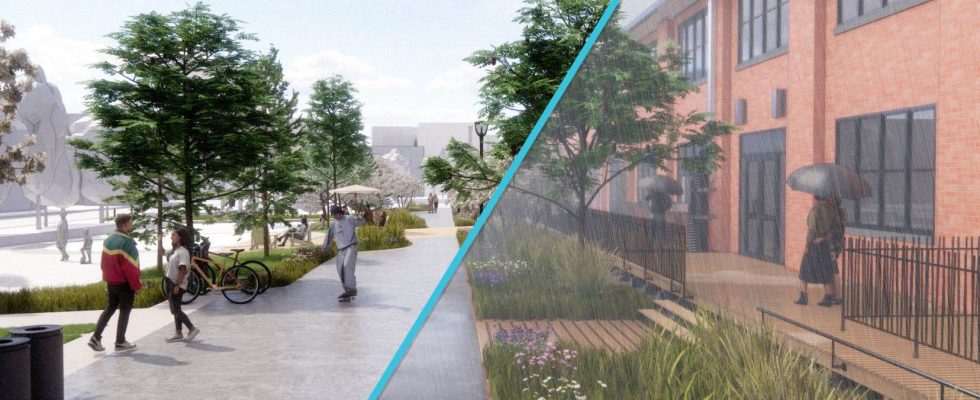Green alleys add a tint of blue to their palette. In Montreal, a new type of development aims to transform these passages into a place of harmony with the rain. Objective: to bring out the sponge of nature buried under the concrete of cities to prevent rainwater from systematically ending up in the municipal network.
Every year, on average, the sky dumps 764 mm of rain on Montreal, according to city data. With the roofs, pavements and parking lots that line the island, each drop has a 75% chance of hitting a mineralized and impermeable surface, a real fast lane to municipal drains.
And although the city’s water and sewer pipes can reach Baghdad end to end, these 9,000 km of pipes fill up quickly in the event of heavy downpours. The deluge that fell on September 13 in Montreal testified, to the great misfortune of the flooded, of the consequences that torrential rain can have on a city and its residents.
Montreal is particularly vulnerable to rain, since two-thirds of its pipes, especially located in the center and in the east of the city, are combined, that is to say that wastewater and runoff end up in the same pipes.
“As they transport rainwater in addition to sanitary water, their flow can increase significantly during storms or intense rain, and even present risks of overflow”, writes the City on the page of its sewer network.
However, a new development model is about to see the light of day in Pointe-Saint-Charles, in Montreal, with the ambition of providing a solution to this problem which affects urban areas that are increasingly subject to the vagaries of the climate. .
The blue-green alleys propose to highlight the water where it falls rather than letting it disappear in a drain directly connected to the municipal pipes.
“We started from the premise that, first and foremost, we must find a different way of managing rainwater in urban areas,” explains Véronique Fournier, Executive Director of the Montreal Urban Ecology Center. We worked from two characteristics of Montreal: its flat roofs and its alleys. »
One stone, many blows
The idea seems simple: divert rain leakage to the outside of the buildings so that its water irrigates the facilities located along the facades. The solution avoids saturating the pipes, while contributing to greening and beautifying the neighborhood.
Since the spring of 2022, the diggers have therefore been busy around Building 7, a formerly disused industrial building converted into a high place of popular mobilization. Valleys and retention basins are now appearing where, barely a year ago, a banal tongue of concrete land spread out. Two weeks ago, the sidewalk that will cross these “rain gardens” came out of the ground.
In June, a brigade of volunteers will put the finishing touches to the site by planting 3,000 shrubs, plants and other herbs, all chosen for their ability to retain water. The borough, for its part, will plant trees to improve the canopy.
In all, Building 7’s blue-green lane will add 625 square meters of green space in the area, and more than 7,500 plants, and will allow the diversion of 9,000 cubic meters of rainwater each year, the equivalent of two Olympic pools and a half that would otherwise end up in the municipal network.
“The philosophy behind the blue-green alley is to kill several birds with one stone,” says Pascale Rouillé, president of Ateliers Ublo, the development firm that designed the project around Building 7. We work on rainwater while greening, creating living environments, bringing back biodiversity, working on mobility within the framework of these projects. I am no longer talking about stormwater management, but about stormwater integration. »
New watershed
In total, the construction of the blue-green alley of Pointe-Saint-Charles will have cost approximately 1.4 million dollars, from its design to its completion. A bill to put into perspective, however, specifies Véronique Fournier, since it has been inflated by the pandemic, and by unforeseen delays due to contaminated soil and the innovative nature of the approach.
Indeed, “for the first time in Canada,” according to the Executive Director of the Montreal Urban Ecology Center, stormwater management is shared between the public and private sectors.
We started from the premise that, first and foremost, we need to find a different way to manage rainwater in urban environments
In this case, Building 7 and the City are working together with the community. The first agrees in particular to divert its plumbing and contribute to the maintenance of the installations in partnership with the public authority. The latter, for its part, is participating in the development and financing of a new kind of alley, which offers a living environment to the local population.
“Water circulates everywhere, it doesn’t stop at land division,” explains Véronique Fournier. We must therefore review its governance because we have no choice but to have a shared solution: no one can have the answer alone in their corner. »
It is with the aim of bringing together the various private, public and community players that the Blue-Green Alleys Alliance was created. It relies on consultation to combine wills and energies around the same common project.
This pooling of responsibilities is unprecedented, and the City had to modify its regulatory framework to bring it to life. The blue-green alley of Pointe-Saint-Charles marked the way, in a way, to facilitate the emergence of other initiatives of the kind.
“The frequency and intensity of the rains that fall on the metropolis will increase,” says Véronique Fournier. In our cities, nature can no longer play its role of sponge since it is far from being dominant in relation to mineralized surfaces. We have no choice, she concludes, to insert green infrastructures into an almost 100% built environment if we want to continue to densify our cities, without having to constantly spend millions to expand our pipes. »
